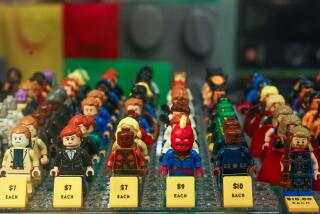The Greats Aren’t Invented, They Just Happen
- Share via
The inventors of some of America’s most popular classic toys have one thing in common: They had no idea what they were doing.
At least that’s what David Hoffman discovered while researching his 1996 book, “Kid Stuff” (Chronicle Books), a brief history of more than 40 classic toys from the Easy-Bake Oven to the Wiffle ball and Monopoly.
“Nine times out of 10, it’s just an accident,” says Hoffman, a Southern California TV reporter and contributor to “Good Morning America.” “Many of these were never even intended to be toys.”
Take, for instance, Silly Putty, which was developed as a potential rubber substitute during World War II by a chemical engineer at General Electric. Only when the “bouncing putty” caught the attention of guests at New Haven, Conn., cocktail parties was it marketed as a novelty gift.
Then there was the marine engineer in Philadelphia who knocked a prototype spring off his desk and watched it walk end over end across the office floor. It wasn’t meant as a toy--the spring was part of an instrument to measure horsepower on battleships--but the engineer was bright enough to see the possible new use.
In 1946, Richard James started his own company. More than a quarter-billion Slinkys later, it looks like a smart move.
“I don’t think the ‘80s and ‘90s will produce classic toys the way the ‘50s and ‘60s did,” Hoffman says. “That was a golden age.”
Hoffman found other curious beginnings for classics. Lincoln Logs were invented by John Lloyd Wright (son of the famous architect Frank Lloyd Wright), who was inspired by the interlocking beams his father designed for Tokyo’s Imperial Hotel. The Frisbee flying disc was named for the pie tins of the Frisbie Pie Co., which students at Yale University loved to toss around in the 1920s.
One characteristic classic toys are sure to have in common: Hoffman calls it the “wow factor.” They caught on quickly once they were discovered, and stayed popular.
“Everything that’s hot today is gone tomorrow, but, meanwhile, Mr. Potato Head is 48 years old. Barbie is 40,” says Hoffman, whose toy histories are being compiled by the Berkshire Museum in Pittsfield, Mass., to be used in a traveling exhibit. “They just keep rolling along.”
Stevanne Auerbach, San Francisco-based author of a weekly syndicated column, “Dr. Toy,” is a big fan of classic toys, but not all of them.
Barbie, the doll and American icon, is not on her list of recommended toys. Her complaint: Its unrealistic proportions (impossibly tiny waist and large chest) send the wrong message to young girls about their body image.
“Give me Raggedy Ann and Andy,” she says.
Here’s a sampling of her favorite classic toys and the age group for which they are recommended: (A complete list is available on her Internet Web site: https://www.drtoy.com.)
* Crayola Crayons (ages 3-11)
* Jumbo Lacing Beads (2-4)
* Lego FreeStyle Bucket (5-12)
* Etch-A-Sketch (4-8)
* Authors Card Game (8-12)
* Ant Farm (6-12)
* Erector Evolution II (8-12)
* Lionel Santa Fe Special Freight Set (8-12)
* Brio Figure-8 set (3-7)
* Measure UP! Cups (1-2)
* Gazoobo (18 months-4 years)
* Samantha Parkington doll (7-12)
* Radio Flyer Classic Red Wagon (18 months-10 years)
* Silly Putty (4-12)
More to Read
Sign up for Essential California
The most important California stories and recommendations in your inbox every morning.
You may occasionally receive promotional content from the Los Angeles Times.













